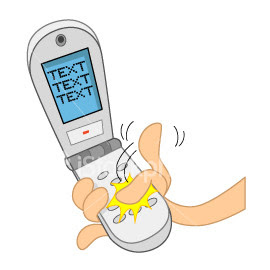SMS: The Gateway Drug for Mobile Search
 Expanding on the bit about text messaging in my previous post, a panel discussion at i2G likewise expanded on the topic.
Expanding on the bit about text messaging in my previous post, a panel discussion at i2G likewise expanded on the topic.
The idea is that despite its lack of sex appeal (compared with other things happening in the mobile world), SMS is where the action is today. Less than 20 percent of mobile users have smartphones, according to TKG data, meaning the vast majority of mobile users are primarily talking and texting.
It’s more the latter, according to Nielsen, which reports that the average mobile user sends 357 texts per month compared with 204 calls. This is a surprising figure to many, and it’s clear that younger users are skewing the average.
“If you’re 25 or younger, it’s the language that you speak,” said Greg Hallinan, VP of marketing for Verve Wireless. This is a point that’s been echoed before. But another segment to which SMS can appeal is small businesses, added Hallinan. Its simplicity lowers the barriers to entry for resource constrained SMBs.
“Their threshold for sophistication is lower and they’re used to direct response [advertising] in print,” he said. “They don’t have mobile Web sites but they do have promotions and a need to get people in the door in a time sensitive way. That can be done easily in SMS in 160 characters or less.”
By time sensitive, Hallinan is referring to promotions that can be turned on and off with SMS campaigns that Verve and others like 4info provide. These can include two-for-one promotions at restaurants, event announcements at dance clubs, etc.
A campaign Verve ran for Boston Magazine for example involved a “brand name distiller” that sponsored a roving happy hour in different bars. Users who opted in received texts containing happy hour details, drink discounts and “front of the line privileges.” Texts were often sent to about 500 users, resulting in 30 percent response rates.
“That’s not a lot in a city like Boston but it was a hit record for these bars, a hit record for Boston Magazine and a hit record for the distiller who sold promotions into these bars,” said Hallinan. “We just provided the service to make it happen.”
Though a lot of potential lies in mobile search and application engagement, it will be contingent upon continued smart phone penetration. Until then, SMS can’t be discounted, as the current leading search input. It sure hasn’t been discounted by the VC community, with very recent funding rounds going to ChaCha ($30 million) and 4info ($20 million).
“It’s the gateway drug to mobile interaction,” said MoVoxx CEO Alec Andronikov.
________
Related: Verve Wireless President Tom Kenney will be a speaker at TKGs Marketplaces conference, March 16-18 in Los Angeles.

If it’s the gateway drug, what comes next? And when?
….and where’s the proof this a true statement?
Good point. i failed to back up the claim – Nielsen reports the average mobile user sends or recieves 357 text messages per month. That’s more than the number of calls they make (204) http://blog.nielsen.com/nielsenwire/online_mobile/in-us-text-messaging-tops-mobile-phone-calling/
I’ll add a note to the post to that effect.
As for what comes next. Moving target. My guess is all the inventory opening up with apps will be an opportunity for display ads, sponsorships, and different ways advertisers can place themselves in the apps. Mobile search is also opportunity (SEM) with search volume growth in mobile – tied to rising smart phone penetration.
But if i knew a definitive answer to that question, i’d be starting a mobile company right now ;).
I love to see the term gateway drug used here–we’ve been saying that, jokingly, since last year, when we launched SMS Triggered search for digital content with a single shortcode across all 3 operators in Thailand. In a week or so we’ll be launching it in the biggest SMS market in the world (win a prize for guessing). In markets migrating from 2G to 3G where WAP/data penetration is c 10% and growing, SMS is the only way to engage millions of users in behaviors they can ultimately migrate to 3G. It grows the market for content providers and advertisers, etc etc.
Full disclosure: I run a media company focused on text message promotions to the generation that believes the web
is tired not wired.
We recently ran a four-day SMS campaign that netted 483% response rate for our client. The audience was perfect for
the promotion. The CTA promotion pulled a 6% subscription rate on one drop. The content URL was available only
in the text messages. More than 4x the subscribed audience visited the site which confirms our belief that a great
campaign goes viral faster in text than anything on YouTube. More, the text subscriber is local and can act on the
message. In addition to the awareness, the campaign subscribers entered over 1200 emails. The cost of each lead was
less than fifty cents each. Cheap, good, fast. Who says you can only have two?